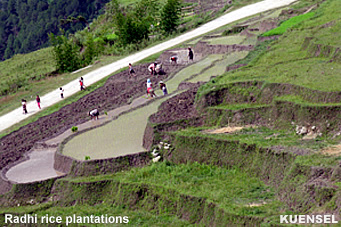 |
Economy: Agriculture |
|
|
 |
|
Trashigang:
Shortage of water has affected paddy fields in Radhi
|
 |
|
Piped water for paddy land expected to solve water shortage
|
| Radhi farmers could live up to their name- rice bowl of eastern Bhutan, once the major irrigation revival program in the gewog is completed, by the end of this year.
After the irrigation canal built in the early 1980s, measuring over three kilometers in length and dug out by excavators was damaged by landslides at several places, farmers became totally dependent on the monsoon.
"We had hopes that it would solve the problem forever but landslides took away the intake source of the canal and we’re left wanting for water," a farmer from Jonla village, Ngawang Tshering said. It was funded by international fund for agriculture development (IFAD).
|
 |
The revival plan is to use huge polythene pipes in places where the original canal was washed away. The survey is complete and Trashigang dzongkhag engineers are working on the designs. The canal has a new in take source and would use over three and a half kilometer of pipes mostly in places prone to slides.
"It requires drilling in to rocks and even using rods at the source of the canal to strengthen it," dzongkhag engineer Chador Phuntsho said.
Radhi Gup Samdrup said most of his gewog’s paddy fields rely on irrigation canals drawn from monsoon fed streams. "Despite the fact that most of our land is paddy fields, there has always been irrigation water shortage," he said.
The project would be funded from funds allocated for activities in the gewog that were dropped from the 10th Plan. As an additional fund, Speaker of the National Assembly and member of parliament from Radhi, Tshogpon Jigme Tshultim had approved his constitutional development grant for the project.
He said the new canal would bring great relief to farmers. Of the 775 households in the gewog, it is expected to benefit over 450 spread over 12 chiwogs.
"It would also allow farmers to do winter cropping," he said.
Farmers said that they had suffered severely, over the past decades; from dry spells as monsoon showers were either delayed or poor. To make things worse, their irrigation canals broke down repeatedly because of loose soil.
Radhi gewog’s rice yield decreased by over 30 percent in 2009 mainly because of lack of rain. Ngawang Tshering said as his fields were located at the bottom of the village, he received little water, as he is the last to receive among 20 households. "I have to depend mostly on the monsoon for transplantation," the farmer from Jonla village said. As water shortage grew acute farmers started to convert their paddy fields in to dry land to grow maize. The project would solve his problems.
However, the gup said that the canal would not reach one village in the gewog, Tongling, as it on the other side of the hill. Farmers said that some villagers in Tongling have left their fields fallow because of the shortage of water.
| Contributed
byTshering Palden, KUENSEL, Bhutan's National Newspaper, 2011 |
 |
| Information on Bhutan |
 |
|



